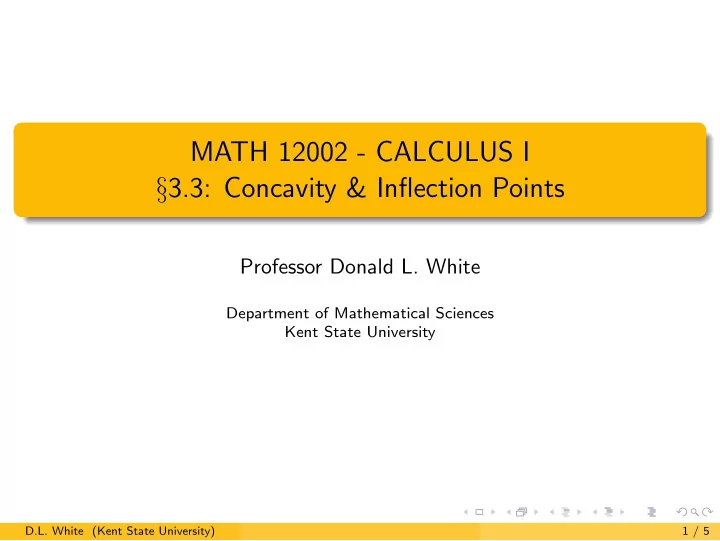

MATH 12002 - CALCULUS I § 3.3: Concavity & Inflection Points Professor Donald L. White Department of Mathematical Sciences Kent State University D.L. White (Kent State University) 1 / 5
Concavity Definition A function f is concave up on an interval if the graph of f lies above its tangent lines on the interval: ✁ ✁ ✫ ✪ ❅ ❅ ✁ ✁ ❅ ❅ CONCAVE UP A function f is concave down on an interval if the graph of f lies under its tangent lines on the interval: ✬ ✩ ❅ ❅ ✁ ✁ ❅ ❅ ✁ ✁ CONCAVE DOWN An inflection point of f (or point of inflection , if you’re not into the whole brevity thing) is a point on the graph of f where f changes concavity from up to down or from down to up. D.L. White (Kent State University) 2 / 5
Concavity We can determine the concavity of f on an interval by finding the sign of the second derivative f ′′ of f . Notice that if f is concave up , the slopes of the tangent lines increase from left to right: ✁ ✁ ✫ ✪ ❅ ❅ ✁ ✁ 2 ❅ ❅ − 1 0 CONCAVE UP Thus f ′ is increasing on the interval, and its derivative, f ′′ , is positive . But if f is concave down , the slopes of the tangent lines decrease from left to right: ✬ ✩ 0 ❅ − 1 ❅ ✁ ✁ 2 ❅ ❅ ✁ ✁ CONCAVE DOWN Thus f ′ is decreasing on the interval, and its derivative, f ′′ , is negative . D.L. White (Kent State University) 3 / 5
Concavity We therefore have: Concavity Test Let y = f ( x ) be a function. If f ′′ ( x ) > 0 on an interval I, then f is concave up on I. If f ′′ ( x ) < 0 on an interval I, then f is concave down on I. Now f ′′ can only change sign at a number c where f ′′ ( c ) = 0 or f ′′ ( c ) is undefined. Since f ′′ is the derivative of f ′ , such a number is a critical number for f ′ . Second Derivative Test for Inflection Point Let y = f ( x ) be a function defined at x = c, where c is a number such that f ′′ ( c ) = 0 or f ′′ ( c ) is undefined. If f ′′ ( x ) changes sign at x = c, then f has an inflection point at c. D.L. White (Kent State University) 4 / 5
Concavity As we noted previously, a function g that is continuous on its domain can change sign only at a zero of g or at a point where g is undefined. To graph a function y = f ( x ) it will therefore be useful to find all numbers where at least one of f ′ or f ′′ is zero or undefined. Between any two such numbers, neither f ′ nor f ′′ can change sign, and so f has one of the following shapes on such an interval: ✬ ✩ ✪ ✫ f ′ + f ′ + f ′ − f ′ − f ′′ + f ′′ + f ′′ − f ′′ − D.L. White (Kent State University) 5 / 5
Recommend
More recommend